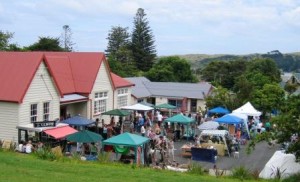Media Release: Historic Places Trust – Pouhere Taonga, Education Heritage Focus for Raglan School

The Heritage of Education is the theme of this year’s International Day for Monuments and Sites on April 18 – a day that highlights and celebrates different aspects of heritage, organised by ICOMOS (the International Council on Monuments and Sites).
And according to Fiona Low – the Lower Northern Manager of the NZ Historic Places Trust – one small Waikato community has a lot to celebrate.
“The Raglan School building is the oldest remaining building in Raglan that has not undergone radical renovation or changes – indeed original features of the building like the open fireplace, pot belly stove, blackboards, vents and internal wall divisions either still exist or can be traced,” says Fiona.
“The building is very much of its era, and illustrates the architectural style of the Auckland Education Board and Government architects who were concerned with erecting impressive yet functional school buildings.”
The school was the first purpose-built secular school in the region with the oldest part of the building completed in 1883.
According to the recollections of some students, school in those days was a bit of a drag – to say the least. One student wrote of being made to stand on a table wearing a tall, white dunce’s cap one day, and on another occasion standing in a corner with a ‘Silence’ placard around her neck as punishment for talking in class.
In those days, school began at 8am with the singing of the National Anthem, saluting the flag and then marching into class.
Like many schools around the country, Raglan School saw a variety of uses over the years – a temporary hospital set up during the 1918-19 influenza epidemic, for example, and as a base for the Home Guard to train during the Second World War.
Local teacher, Mrs C Peart, recalled air raid drills during the war years:
“We…had to drill the children in air raid precautions. At the ringing of a handbell they had to be marched out and rush helter skelter to any shelter they could find – under trees, in ditches or under hedges. The children thought the exercises great fun.”
The school is part of a long tradition in Raglan of bicultural attitudes which has ranged from the election of a kaumatua to the school committee in 1881 to the attendance at school of Maori and Pakeha children, the building of a whare in the grounds in 1933, and the continued involvement of former pupils such as Tuaiwa (Eva) Rickard, who successfully advocated against the building’s demolition in 1988.
“The Raglan School building is a place of great significance to the people of Raglan who justifiably regard it with considerable pride, and the building was registered as a Category 2 historic place in 2008,” says Fiona.
The school has always had a central focus for the community at Raglan – as a school until 1962, and more recently as an Arts Centre.
According to Jenny May, the Chair of ICOMOS New Zealand, the International Day for Monuments and Sites seeks to encourage local communities and individuals around the world to consider the importance of cultural heritage to their lives, identities and communities.
“Education in New Zealand was practised in a wide range of places – including communities like Raglan. Buildings and sites associated with early education initiatives – like the Raglan School building – are a significant part of our cultural heritage,” she says.
“The International Day for Monuments and Sites provides a good opportunity for us to reflect on the very important part education has played in the evolution of our cultural and built heritage.”

